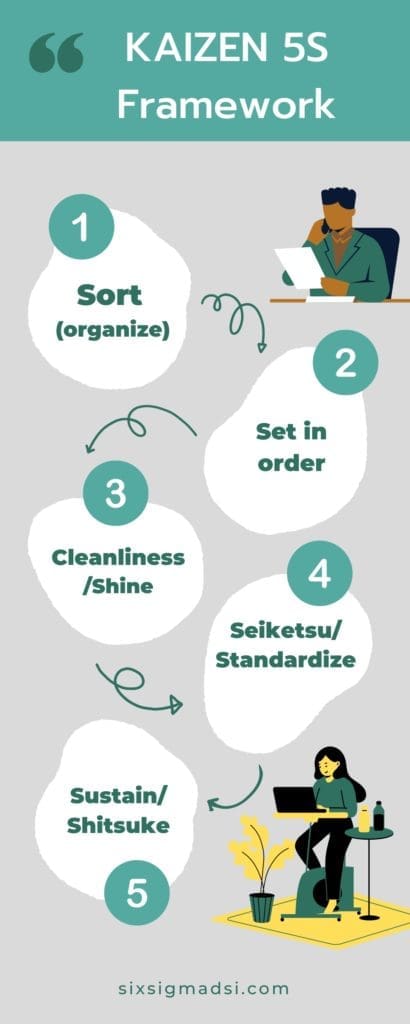Table of contents
The Process Improvement Framework
Every business has standard processes and practices that help it achieve its objectives more efficiently. Business processes can become outdated over time, leading to project delays and higher costs. You should therefore perform regular process improvement framework methodology tools and exercises.
The pandemic, for example, was the digital accelerator of the decade. digitalization was critical to corporate survival. Amazon was one of the few companies that were able to adapt with their user-friendly interfaces, self-service, and no-contact options for delivery. Amazon has increased its market capitalization to $700 Billion due to its continual investment in improving its business processes.
How can you improve the processes in your company? Which methodology will produce the best results? This guide will help you get started with the best methods for process improvement.
What is Process Improvement?
Process improvement is also known as business process improvement (BPI), or continuous improvement process, and it is the practice that optimizes existing business processes in order to meet industry standards while improving customer experience.
The goal of process improvement is to identify, analyze, and improve workflows. The process can be modified, enhanced with sub-processes, or eliminated to achieve the goal of improvement.
Process Improvement vs. Business Process Management
Process improvement and business process management are often used interchangeably. The question is whether the two concepts have the same goals and are the same. However, there are some differences.
Business Process Improvement is focused on improving customer value by improving quality, and service, and reducing costs.
Business Process Management ensures effective communication throughout an organization. Business process management integrates process documentation, improvement, performance management, and organizational change management, with technological change, to ensure success and sustainability in process improvements.

Improved processes can positively impact organizations
Here are some of the direct benefits of process improvements for your business.
1. Productivity can be improved
According to research, over 40 percent of employees spend a minimum of a quarter of the week performing manual, repetitive tasks, such as data collection and data entry. A custom application or technological change can automate repetitive tasks and allow employees to reallocate their time toward core aspects of their jobs.
2. Enhance User Experience
76% feel that companies must reengineer user experiences to bring people and technology closer together. Facebook has recently made a bid to become a Metaverse Company. It aims to use advanced technologies like AR &VR to bring the digital and physical worlds together in a way that has never been seen before.
3. More Agile
Flexi-processes play a critical role in staying competitive in the market. Business process improvement methodology is focused on the implementation of flexible processes that are easy to deploy and can be adapted as your business requirements evolve.
4. Cost Reduction
By finding the best solutions for a process, it is possible to reduce resource consumption and waste. These methods allow businesses to reduce expenses like unplanned overtime, premium shipping, and other costs.
5. Compliance
Regulatory standards change as business needs evolve. Regular compliance education is required to ensure that your employees are ready. This can be difficult without the help of external experts. Third-party consultants use process improvement techniques to document compliance-related procedures, policies, and internal control. By incorporating compliance into new business processes, you can avoid unnecessary fines and penalties.
Google, for example, undergoes independent audits to ensure that its privacy, security, and compliance controls are up-to-date. It strives to continuously improve its compliance offerings and business processes.
6. Reduced Cycle Time
Kanban is a process improvement methodology that helps businesses deliver value quickly to their customers. Process improvement also leads to shorter delivery cycles by eliminating waste, improving communication, and collaborating.
7. Better Quality
Business process improvement, in addition to speeding up product development, can also improve the quality of products. By deploying the right testing methods, for example, organizations can make sure that the products are only put into production after all performance, security, and other issues have been resolved.
The 10 Best Process Improvement Techniques and Methodologies
70% of process improvement tools and initiatives will fail if changes are not implemented successfully in the organization. It’s important to know which method best suits your business and have an implementation strategy prepared.
Here are 10 techniques that will help you kickstart your process improvement initiative.
1. Agile Methodology
An agile approach involves more iterations, rather than defining a project with strict deadlines. It takes into account team feedback and highlights problems as well as successes in order to improve the project. A flexible methodology enhances communication and collaboration between stakeholders and allows for easier adaptation to change.
2. Six Sigma
Six Sigma is an established technique that reduces variability and defects down to below 3.4 per million units. The goal is to maximize value and minimize errors across industries using data and statistics. To achieve the desired result, process engineers can use the DMAIC technique (define measure analyze improve, and control) or DMADV (define measure analyze the design, and verify).
It is noteworthy that many organizations skip the first three stages and jump straight to the design or improvement stage. This leads to the failure of the project. General Electric, an American multinational, struggled to improve the quality of its products and services even after hiring experienced professionals. After incorporating Six Sigma into their business processes, they were able to streamline their processes and increase revenue.
3. Lean Manufacturing
Lean manufacturing is a method of reducing costs by eliminating waste. The name of this method suggests it is only applicable to manufacturing, but its basic principles can be used in other industries. This technique and tools can be used effectively by the process improvement team if they map the value stream in order to understand the buyer’s perception. This will enable them to remove waste and redundancy successfully from business processes.
Intel, for example, adopted lean manufacturing to produce higher-quality processors in a shorter timeframe. Intel has reduced the time it takes to deliver a microchip from more than 3 months to less than ten days by implementing quality control and waste reduction techniques.
4. Total Quality Management (TQM).
TQM is a way to improve customer satisfaction through a continuous process improvement methodology. This improvement method empowers employees through a changing culture that encourages them to be open to experimenting and has a common business goal. The TQM can be implemented differently across industries. However, organizations that use TQM follow the following principles:
- To achieve business goals, organizations should adopt a strategic and systematic approach.
- The level of service is determined by the customer.
- Effective communication and techniques for employee training are essential to ensuring that employees know the meaning of quality and strive towards it.
- The organization should establish a process framework, and then monitor the performance to detect deviations.
5. Just-In-Time
The Toyota Production System is a form of Just-In-Time manufacturing that aims to reduce inventory costs while increasing efficiency. Toyota executives created this concept to reduce inventory losses and adapt quickly to changes in demand.
It encourages a “pull” strategy rather than a “push” strategy. It is implemented often with the Kanban method to avoid overcapacity and requires accurate forecasting as well as steady production.
6. Theory of Constraints
The Theory of Constraints is a technique that is highly focused on creating rapid improvements. It identifies bottlenecks in the process and works to eliminate them.
7. Kaizen
Kaizen is a lean, agile approach to improving the productivity and quality of processes by making small changes in corporate culture and work practices.
For example, Mitsubishi Heavy Industries America(MHIA) initially created tailor-made(design-to-order) chemical & environmental plant designs. After incorporating the Kaizen methodology into its design process, it made small and continuous changes in order to create a standard module package. This resulted in a reduction of errors during the design phase, and a cost saving for the customer between 5-10%.

8. PDCA Model
This technique is part of the Kaizen method. PDCA is an acronym for Plan, Do, Check, and Act. It allows organizations to identify processes that require improvement.
9. Process Mapping
Process mapping is an effective workflow visualization tool that allows companies to map out their plan for improving processes from beginning to end. Visualizations can take the form of process flowcharts, functional flowcharts, or process models. You can create process mappings specific to roles and business goals in order to analyze the activities of your organization to improve productivity.
10. Kanban
Kanban is an effective visual workflow technique that helps identify problems, eliminate bottlenecks and improve efficiency. It also tracks the progress of any process improvement tools and initiatives.
For example, the fashion retail giant Zara uses Kanban Boards at the store level to identify what clothes need to be manufactured and in what quantities. Store managers submit a biweekly purchase order to headquarters based on sales data, and what loyal customers are asking for. The order is updated with the latest clothing styles and arrives in the store within two days. Zara’s lean production methods have made Inditex, the parent company of Zara, the largest clothing retailer on the planet.
Have you used the process improvement framework in your six sigma project?
Tell us about your experience or questions below.



















